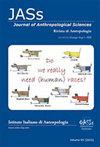What made us human? Biological and cultural evolution of Homo sapiens.
IF 2.3
2区 社会学
Q1 ANTHROPOLOGY
Journal of Anthropological Sciences
Pub Date : 2016-06-20
Epub Date: 2015-05-05
DOI:10.4436/JASS.94036
引用次数: 37
Abstract
The science of human evolution has recently been changing rapidly, and we know that Homo sapiens is the last surviving branch of a once-luxuriant tree of hominid species. Until very recent times, our lineage shared the planet with several other human species, such as those containing Homo neanderthalensis, Homo erectus and Homo floresiensis. Following its biological and anatomical birth in Africa around 200,000 years ago Homo sapiens spread around the world, following multiple paths of expansion that we can now track using the techniques of molecular biology, ancient DNA studies and paleoanthropology. In this global, ecological and demographic scenario, at one point our species began to express cognitively modern behaviors: a “symbolic intelligence” so peculiar that scientists view it as the hallmark of human creativity and uniqueness itself. Was there a gap between our biological birth and our intellectual birth? Was the process a gradual or a punctuational one? What triggered the so-called Paleolithic Revolution? How did our cultural evolution interact with our biological evolution? What might have been the role of other human species? Is articulate language our “secret weapon”? This Special Issue addresses these questions, gathering the contributions presented in the meeting held in the beautiful context of the Erice International School of Ethology1 from October 14th – 19th, 2014. Very importantly, the versions published here have been updated with the latest findings and the most recent literature. The workshop was the second in a program of meetings dedicated to human evolution and human uniqueness, and followed the first workshop held in June 2012, titled Evolved Morality. The biology and philosophy of human conscience2. The meeting involved prominent experts in primatology, paleoanthropology, genetics, anthropology, ethology and philosophy, and originated in discussions between paleoanthropologist Ian Tattersall, philosopher of science Telmo Pievani and ethologist Stefano Parmigiani, on how best to shed light on deep questions that necessarily require a cross-disciplinary effort.是什么让我们成为人类?智人的生物和文化进化。
本文章由计算机程序翻译,如有差异,请以英文原文为准。
求助全文
约1分钟内获得全文
求助全文
来源期刊

Journal of Anthropological Sciences
Social Sciences-Anthropology
CiteScore
2.20
自引率
5.60%
发文量
7
期刊介绍:
The Journal of Anthropological Sciences (JASs) publishes reviews, original papers and notes concerning human paleontology, prehistory, biology and genetics of extinct and extant populations. Particular attention is paid to the significance of Anthropology as an interdisciplinary field of research. Only papers in English can be considered for publication. All contributions are revised by the editorial board together with the panel of referees.
 求助内容:
求助内容: 应助结果提醒方式:
应助结果提醒方式:


